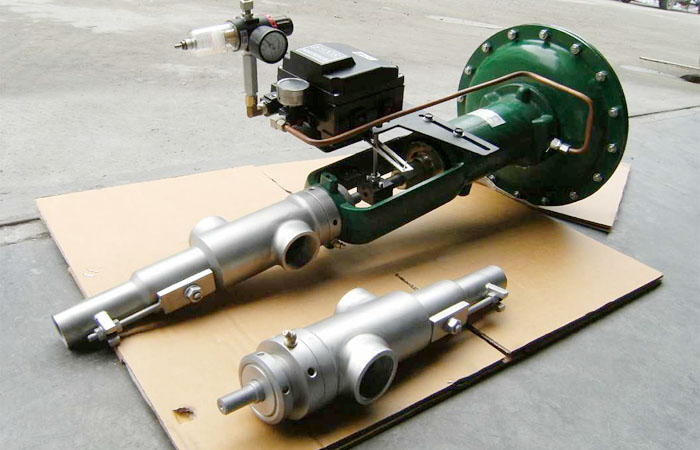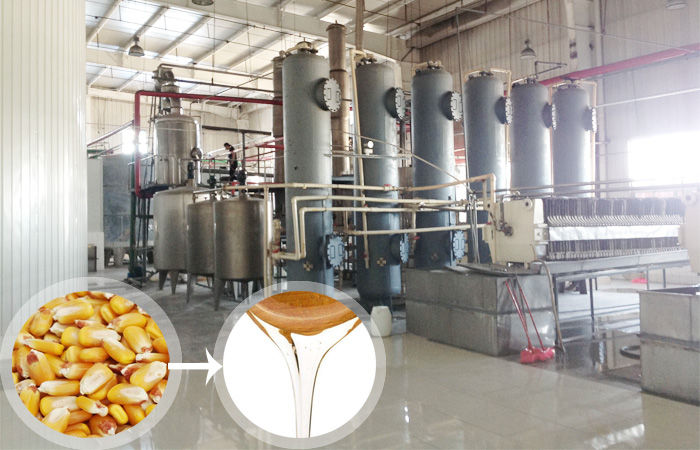Liquefaction and saccharification process of starch for syrup production
2018-10-29
/Syrup Processing
Taking the preparation of maltose syrup as an example, the paper mainly introduces the liquefaction and saccharification process of starch in the process of preparing high-purity maltose syrup by corn amylase. Raw materials: corn starch; product: high-purity maltose syrup; technology: full enzymatic method.
Before introduce the liquefaction and saccharification process of starch, let's see the data during processing:
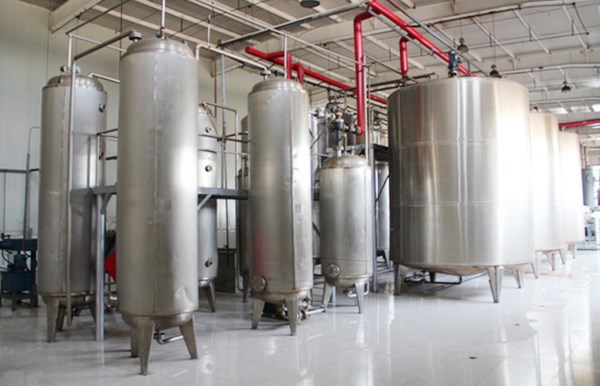
DOING liquefaction tanks
When high maltose corn syrup is produced in industrial production, the liquefaction process of starch directly affects the difficulty of operation of the saccharification process and the quality of the finished product. Starch liquefaction involves two stages, namely fully gelatinized starch for moderate degradation to reduce viscosity and prevent aging. Only on this basis to ensure the uniformity of fully gelatinized starch, it is possible to achieve a degree of degradation of sustained consistency. Therefore, starch, gelatinized starch is an important operating unit for syrup production. Gelatinization refers to the full expansion of starch granules under heating conditions, from an ordered state to a disordered state. The specific loss of crystal water loss of the absorbed starch granules is reflected in the process of "paste", the starch protein is separated and concentrated, and the starch gelatinization can only be through the action of the enzyme. Different starches require different temperatures for complete gelatinization. Grain starch is more difficult to gelatinize than potato starch, but if the gelatinization temperature is 105 °C to 110 °C, most of the starch gelatinization requirements can be met. Therefore, the general liquefaction process of starch, the liquefaction temperature is 110 ° C, in the extended expansion period of the larger starch molecular chain, the attack point of the enzyme molecule also increases accordingly, so the starch glycoside chain is easy to cut, and the liquefaction is relatively complete.
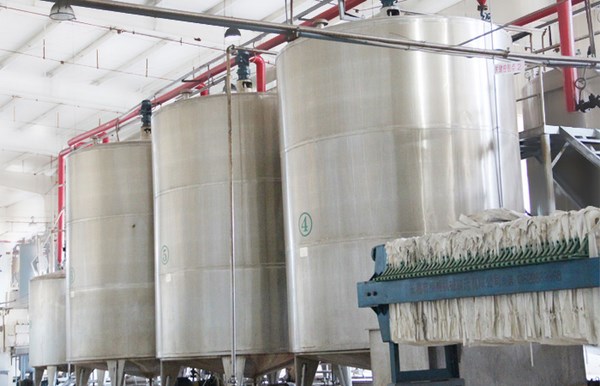
Saccharification tank
In the production of maltose syrup, the concentration of starch milk reaches 30% or more, and the viscosity after gelatinization is high, which is difficult to handle, and therefore it is necessary to carry out liquefaction, to lower the viscosity and partially hydrolyze, and to prevent precipitation aging when the starch is cooled. Liquefaction is the process of dispersing starch molecules in water and partially hydrolyzing them. Once the starch is liquefied, it can expose more non-reducing ends that are affected by alpha-amylase. Liquefaction can be carried out with an acid or an alpha-amylase.
There are many reports on the research of liquefaction process of starch. There are two main indicators for liquefaction research: First, the iodine color reaction is used as a detection index to control the degree of liquefaction. This method is influenced by subjective factors. It is not very accurate; the second is to use the DE value of liquefaction as the detection index to control the degree of liquefaction. The DE value can accurately reflect the degree of liquefaction of starch, and the relative accuracy is high. Therefore, most of the production and experimental studies use liquefied liquid. The DE value is used as a test indicator for liquefaction. In order to increase the yield of maltose, it is also necessary to prevent the formation of an oligosaccharide having an odd degree of polymerization of glucose. The higher the DE value after liquefaction, the greater the chance of generating an odd degree of polymerization of oligosaccharides, which will produce more maltotriose after saccharification and lower the yield of maltose.
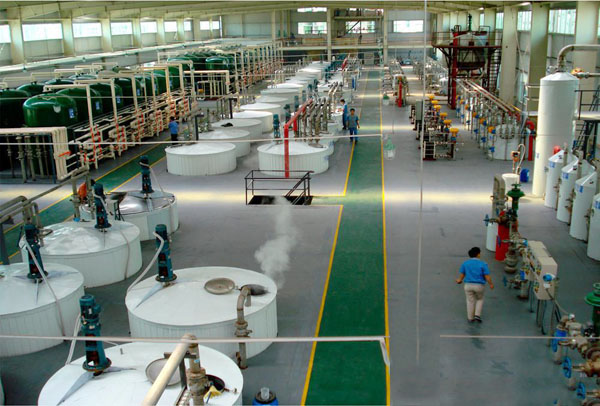
Syrup manufacturing plant
Saccharification process: After the starchy raw material is gelatinized and liquefied, a small amount of glucose is produced, and a large amount of dextrin and oligosaccharide are used. In order to hydrolyze the starch more thoroughly, it needs to be saccharified with an acid or an enzyme. Enzymatic saccharification refers to the further hydrolysis of the liquefied product to maltose using a saccharification enzyme.
The saccharification process of starch is extremely important in the production process of maltose syrup. In addition to a small amount of glucose, the liquefied liquid after liquefaction is mainly a large amount of dextrin and oligosaccharides, so the liquefied liquid must be continuously converted into high-purity maltose by the action of saccharifying enzyme. Pulp. The key to this process is the ability of the saccharifying enzyme to cut the oligosaccharides and limit dextrin in the liquefied liquid into maltose as much as possible. During the saccharification process of starch, the temperature is controlled within the range of 58 ° C to 60 ° C, and the pH is controlled within the range of 5.8 to 6.0 to ensure that the saccharification enzyme exerts the best catalytic action. That is, the saccharification enzyme cleaves the α-1,4 glycosidic bond or the maltose molecule sequentially from the non-reducing end or the reducing end of the substrate starch molecule. In the actual production process, some of the branched enzymes are often added during the saccharification process of starch because of the presence of many amylopectin. For example, pullulanase and isoamylase can cleave the α-1,6 glycosidic linkage at the amylopectin branch, thus forming more oligosaccharides that can be hydrolyzed to maltose by the saccharification enzyme. Through the synergy between various saccharification enzymes, the α-1,4 glycosidic bond and the α-1,6 glycosidic bond are continuously cleaved, and a large amount of maltose is finally produced, thereby producing a high-quality maltose syrup.
The saccharification solution obtained after the saccharification process is decolorized by filtration and purified to obtain an edible syrup, and then excess water is removed by an evaporator to obtain a desired finished maltose syrup. (The machines used in these parts mainly include plate and frame filter presses, ion exchange columns, evaporators)
Before introduce the liquefaction and saccharification process of starch, let's see the data during processing:
| Liquefaction | DE | 11%-15% | |
| Temperature | 106-108℃ | ||
| Saccharification | Temperature | when add enzyme | 60-62℃ |
| PH | 4.2-4.4 | ||
| DE | |||
| outer | >99% | ||
| Time | 48-52h | ||

DOING liquefaction tanks

Saccharification tank
There are many reports on the research of liquefaction process of starch. There are two main indicators for liquefaction research: First, the iodine color reaction is used as a detection index to control the degree of liquefaction. This method is influenced by subjective factors. It is not very accurate; the second is to use the DE value of liquefaction as the detection index to control the degree of liquefaction. The DE value can accurately reflect the degree of liquefaction of starch, and the relative accuracy is high. Therefore, most of the production and experimental studies use liquefied liquid. The DE value is used as a test indicator for liquefaction. In order to increase the yield of maltose, it is also necessary to prevent the formation of an oligosaccharide having an odd degree of polymerization of glucose. The higher the DE value after liquefaction, the greater the chance of generating an odd degree of polymerization of oligosaccharides, which will produce more maltotriose after saccharification and lower the yield of maltose.

Syrup manufacturing plant
The saccharification process of starch is extremely important in the production process of maltose syrup. In addition to a small amount of glucose, the liquefied liquid after liquefaction is mainly a large amount of dextrin and oligosaccharides, so the liquefied liquid must be continuously converted into high-purity maltose by the action of saccharifying enzyme. Pulp. The key to this process is the ability of the saccharifying enzyme to cut the oligosaccharides and limit dextrin in the liquefied liquid into maltose as much as possible. During the saccharification process of starch, the temperature is controlled within the range of 58 ° C to 60 ° C, and the pH is controlled within the range of 5.8 to 6.0 to ensure that the saccharification enzyme exerts the best catalytic action. That is, the saccharification enzyme cleaves the α-1,4 glycosidic bond or the maltose molecule sequentially from the non-reducing end or the reducing end of the substrate starch molecule. In the actual production process, some of the branched enzymes are often added during the saccharification process of starch because of the presence of many amylopectin. For example, pullulanase and isoamylase can cleave the α-1,6 glycosidic linkage at the amylopectin branch, thus forming more oligosaccharides that can be hydrolyzed to maltose by the saccharification enzyme. Through the synergy between various saccharification enzymes, the α-1,4 glycosidic bond and the α-1,6 glycosidic bond are continuously cleaved, and a large amount of maltose is finally produced, thereby producing a high-quality maltose syrup.
The saccharification solution obtained after the saccharification process is decolorized by filtration and purified to obtain an edible syrup, and then excess water is removed by an evaporator to obtain a desired finished maltose syrup. (The machines used in these parts mainly include plate and frame filter presses, ion exchange columns, evaporators)
- Prev:Ion exchange resin usage and regeneration
- Next:Sterilization and pollution prevention in glucose syrup processing
Leave A Message About Liquefaction and saccharification process of starch for syrup production
- Director: Ms Elina Wu
- Phone: 0086 135 2661 5783
- WhatsApp: 0086 135 2661 5783
- Tel: 0086 371 5677 1822
- sales@syrupmachine.com
- Chat Online
- Ion exchange resin equiped in ion exchange column, its necessary for t...
- When high maltose corn syrup is produced in industrial production,the ...
- Here bellow introduces the sterilization and pollution prevention when...
- And we can install the corn syrup plant fou you.Corn syrup is produced...
- Corn syrup production steps introduce the way of how to make glucose s...
- The liquid glucose manufacturing process completed by one complete set...
- Corn syrup production process is a process of converting corn into syr...
- DOING adopt the modern and advanced technology for liquid syrup manufa...
- Starch syrup manufacturing process introductions and the main equipmen...
- Syrup evaporator is key equipment in glucose production line,there are...
